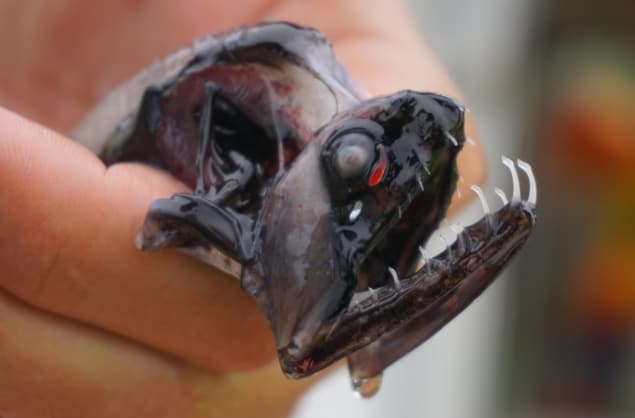 Toothy grin: the deep-sea dragonfish. (Courtesy: Audrey Velasco)
Toothy grin: the deep-sea dragonfish. (Courtesy: Audrey Velasco)
In the darkness of the ocean’s midnight zone the deep-sea dragonfish, glows with bioluminescence to lure prey before striking with its transparent, sabre-like teeth. The transparency makes the teeth and wide-open mouth of this ferocious predator invisible to prey as it hunts and now a team of oceanographers and material scientists have discovered that this invisibility is a result of a unique nanoscale structure. The team hopes that their discovery will inspire the development of super-tough, but transparent materials.
The deep-sea dragonfish has a dark, eel-like body and a disproportionately large head and mouth filled with immense, sharp and transparent teeth. Indeed, the teeth can be so large that they stick out of the mouth when it is closed. While the fish are small – about the length of a pencil – they are apex predators in the aphotic zone of the ocean, where they live at depths of at least 1000 m. The fish attract and illuminate prey in the darkness using a bioluminescent barbel that hangs under their chin. A mechanism known as loosejaw allows the deep-sea dragonfish to eat fish that are up to half their own size.
Marc Meyer, an expert in bioinspired materials at the University of California, San Diego says that the transparent teeth have probably evolved to assist with hunting. “We propose that they are transparent, so the dragonfish can conceal the teeth and just keep their mouth open with the little light source,” he told Physics World. “Then the prey comes and bang it is trapped in this huge mouth. If the prey were to see the teeth, they would shy away.”
Unique nanoscale structure
Intrigued by the transparent nature of the teeth, Meyers and colleagues in San Diego and the Leibniz Institute for New Materials in Germany, examined deep-sea dragonfish collected from the San Diego Trough, a 1000 m deep ocean canyon off the Californian coast. When they looked at the teeth with scanning electron and X-ray microscopes they discovered that they have a unique nanoscale structure that reduces light scattering.
Like most teeth, the teeth of deep-sea dragonfish consist of an outer enamel-like layer over an inner dentin layer. The dentin layer, however, lacks the typical microscale tubules of other teeth. Instead, the team’s analysis revealed that it is comprised of an interwoven pattern of much smaller nanorods, which are around 5 nm in diameter. The enamel-layer also features a nanoscale structure, consisting of 20 nm crystals in an amorphous matrix.
The nanostructures are smaller than the wavelength of visible light and Meyer says that this allows them to reduce Rayleigh scattering from the teeth. This scattering is a well-known phenomenon that depends on particle-size: the smaller the particles the less they scatter light. “The resulting effect is that the very small particles, the nanocrystals, scatter the light very little and you end up not having any light that is reflected or scattered. Most of the light is transmitted, especially if the tooth is in the water,” Meyers explains.
Bioluminescent allure
While there is little sunlight in the aphotic zone, many denizens of the deep like the dragonfish are bioluminescent. “We think it is the light from their lure, it is the light that they generate that they are transmitting [through their teeth],” Meyers explains.
The nanoscale structure also makes the teeth very strong. While the mechanical properties of the enamel-like layer are similar, the researchers found that the dentin is much harder and stiffer than that of a piranha or great white shark. While the dentin layer of the great white shark and piranha have hardnesses of 0.2 GPa and 0.3 GPa, respectively, the deep-sea dragonfish’s dentin was found to have an average hardness of 1.2 GPa.
The team now hope to use the knowledge gained from the teeth to create glass-like ceramics, which could be used for applications such as ultra-strong windows. “We are always looking for bio-inspired structures, but it is a long road,” Meyers says.
The work is described in Matter.

